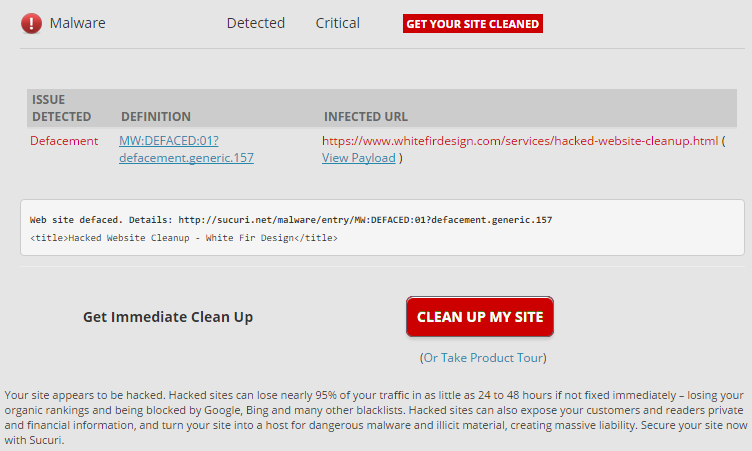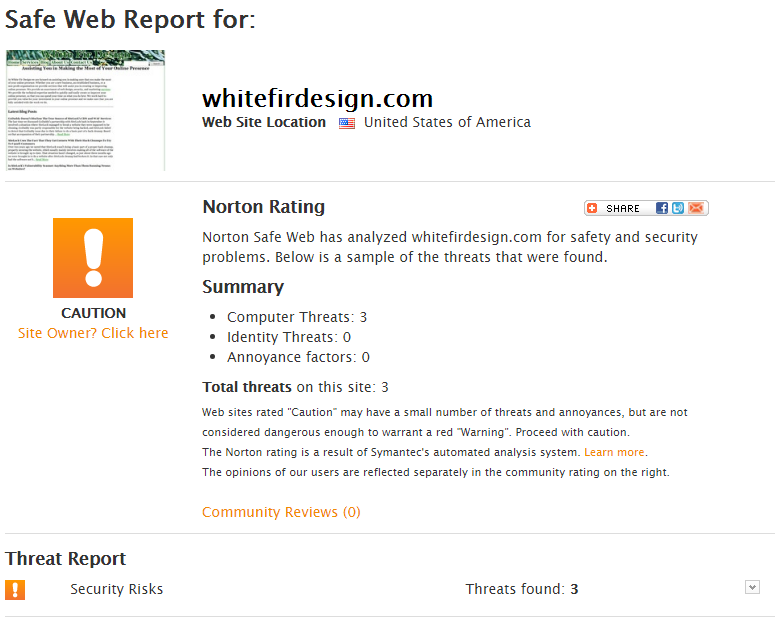In the past we have discussed the fact that the web security company Sucuri’s scanner SiteCheck is rather poor at what it does, including falsely claiming that a website was infected with malware due to a bad false positive and claiming that a website was running on outdated software without knowing if that was true.
We just ran across another example, which this time involves our own website. On a post about them astroturfing from four years ago, we recently got this comment:
The Scam is strong with this one
If you follow that link as of us writing this you will see that the status of our website is “Website Defaced (hacked)”:
Not only is it not actually defaced, but there reason for claiming that is just baffling, as the claim is based on the title of one of the pages on our website being “Hacked Website Cleanup – White Fir Design”:
It would appear they are claiming that a website is defaced just due to the words “hacked” and “website” in the title of a page, which clearly isn’t reliable to determine if a website is defaced. On top of that they are claiming an issue that doesn’t actually exist is of “Critical” severity.
We of course can spot that their claim was wrong since we deal with websites that are actually hacked all the time (and it was quite obvious at least in this case), but based on plenty of experience dealing with people that think that their websites have been hacked, we would guess that a lot of webmasters and owners could be mislead by this type of thing, leading to some of them paying Sucuri to clean up a hack that didn’t exist.
Sucuri Also Misrepresents Other Companies Data
The problems with their scanner don’t end there as the results for our website show. They also mention that our website is “Blacklisted”:
Looking into the details of that they claim the website is blacklisted by Norton Safe Web:
The reality is lot less alarming then they claim. Here are the Norton results:
What seems rather relevant to that is this part:
Web sites rated “Caution” may have a small number of threats and annoyances, but are not considered dangerous enough to warrant a red “Warning”.
So unlike Sucuri they don’t think that it should get a red warning.
So what are the threats on our website? There are not any, instead Norton’s scanner doesn’t understand the difference between showing malicious code in harmless form on one of our website’s pages, with actual malicious code on a website (the poor quality of website scanners isn’t limited to Sucuri):
While Sucuri warning if websites are actually blacklisted by other services would be useful, it should be accompanied by a disclaimer that the other services results may not be accurate instead of overhyping the issue to try to sell their services.
A Better Way to Get Your Website Check to Confirm if it is Hacked
Based on all that there is plenty of reason to avoid Sucuri’s SiteCheck, but what is a better way to confirm whether your website is hacked if you believe it is? The simple answer is to contact us, as we are happy to do a free check to confirm whether a website is hacked or not. We don’t rely on low quality automated tools to do that, since they produce poor results as was shown above. Instead we will discuss the situation with you and then do any necessary checking to look into the possible issue. For websites that are hacked we will also provide a free consultation on how best to deal with the issue, instead of trying to scare you into using our services, unlike Sucuri.








